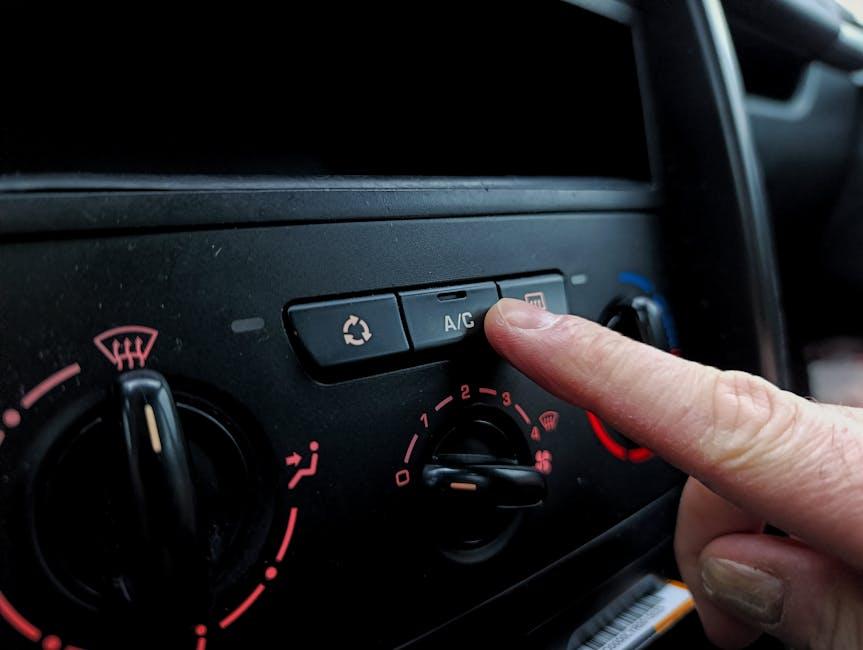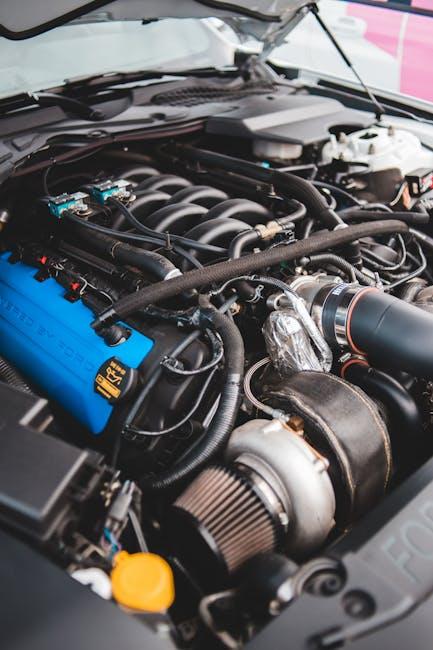On a sweltering summer day, few comforts rival the cool embrace of a well-functioning car air conditioning system. Yet, as time wears on, that refreshing chill can become a distant memory, replaced by tepid, barely-there airflow. When this happens, many drivers find themselves wondering: is recharging the AC gas really necessary, or is it just another automotive myth? In this article, we’ll explore the ins and outs of car AC gas recharge—what it does, when it’s needed, and how to tell if your vehicle truly requires this service. Whether you’re a seasoned driver or a curious first-timer, understanding this aspect of car maintenance can keep your journeys cool and comfortable all year round.
Table of Contents
- Understanding How Your Car AC System Works
- Common Signs That Indicate Your AC Needs a Recharge
- The Risks of Overcharging Versus Undercharging Your AC Gas
- Step-by-Step Guide to Checking Your Car AC Gas Levels
- When to Consult a Professional for AC Maintenance
- Best Practices to Prolong the Life of Your Car’s Air Conditioning System
- Q&A
- In Retrospect

Understanding How Your Car AC System Works
The car air conditioning system operates as a delicate balance of components working together to maintain a chilly environment inside your vehicle. At its heart lies the refrigerant, often referred to as “AC gas,” which absorbs heat from the cabin and releases it outside through a complex cycle of compression and expansion. The key parts involved include the compressor, condenser, expansion valve, and evaporator, each playing a crucial role in ensuring efficient cooling. Without the correct amount of refrigerant, the system struggles to regulate temperature, causing weak or inconsistent airflow that can quickly turn a pleasant drive into an uncomfortable experience.
Keeping the refrigerant levels in check isn’t just about comfort—it affects the longevity and performance of your AC components. A properly charged system means:
- Efficient cooling that quickly lowers cabin temperature.
- Reduced wear and tear on the compressor, preventing costly repairs.
- Optimal energy consumption, helping save fuel.
Regular maintenance checks can identify leaks or drops in refrigerant levels early, making recharging necessary only when these signs appear. Understanding this balance helps you decide when a recharge can truly benefit your vehicle’s comfort and system health.

Common Signs That Indicate Your AC Needs a Recharge
When your car’s AC isn’t performing like it used to, it’s often more than just a minor inconvenience. You may start noticing that the air blowing from the vents is barely cool or feels warm altogether. Another subtle yet telling sign is a hissing sound coming from the dashboard, signaling a potential refrigerant leak. Alongside these, some drivers report a damp or musty odor whenever the AC is turned on, which can be a clue that the system is struggling due to low refrigerant levels.
Other indicators that your system might need a gas top-up include:
- Longer cooling times: The AC takes noticeably more time to cool the car interior.
- Weak airflow: Even on the highest fan settings, the output is barely noticeable.
- AC compressor cycling: The compressor turns on and off frequently, hinting at pressure irregularities.
- Frequent fogging: Windows fog up excessively when the AC is active, affecting visibility.

The Risks of Overcharging Versus Undercharging Your AC Gas
When it comes to topping up your car’s AC gas, precision is key. Overcharging the system can lead to increased pressure inside the AC unit, causing potential damage to components like the compressor. This not only shortens the lifespan of your AC system but can also lead to higher repair costs. Additionally, overfilled gas can reduce cooling efficiency, ironically leaving you feeling less comfortable on hot days.
On the other hand, undercharging your AC system can be just as detrimental. Insufficient gas means your car’s AC won’t cool effectively, making drives unpleasant during the summer months. The system will work harder to achieve the desired cooling, which can strain parts and increase fuel consumption. Below is a quick glance at the potential effects:
| Condition | Effects |
|---|---|
| Overcharging |
|
| Undercharging |
|

Step-by-Step Guide to Checking Your Car AC Gas Levels
Begin by locating your car’s AC service ports, typically found along the refrigerant lines. These ports are designed for easy access and are labeled as “high” and “low” pressure sides. Before connecting any gauges, make sure your engine and AC system are turned off to avoid injury or inaccurate readings. Once identified, attach a refrigerant pressure gauge to the low-pressure port. After starting the engine and turning on the AC to its maximum cold setting, observe the gauge readings. This method gives a direct insight into your system’s refrigerant levels and pressure condition.
Alongside gauge readings, pay attention to symptoms such as weak cooling, strange noises, or visible leaks under the car. Use the following quick checklist to evaluate your findings:
- Proper Pressure Range: 25-45 psi on the low side.
- Temperature Drop: Expect a 15-25°F decrease at the vents.
- Hissing Sounds: Could indicate leaks.
- Oil Residue: A sign of refrigerant leakage around joints.
If measurements fall outside these criteria or issues persist, it might be time for a professional recharge or repair to maintain optimal performance.

When to Consult a Professional for AC Maintenance
Recognizing when to seek expert help can save you from costly repairs and inconvenience. If your car’s AC system is blowing warm air despite regular operation, it’s a clear indicator that professional evaluation is necessary. Other signs include unusual noises, unpleasant odors coming from the vents, or moisture buildup inside the cabin. Attempting to recharge the gas on your own without the right tools or experience can lead to overcharging, leaks, or damage to the system’s components.
Professional technicians not only have the equipment to detect leaks and assess the system’s pressure accurately but also ensure the correct type and amount of refrigerant is used. It’s advisable to consult a specialist if you notice any of the following signs:
- Reduced cooling efficiency over time
- Frequent need to recharge the AC refrigerant
- Visible refrigerant leaks or oily residue
- AC compressor cycling on and off abnormally
| Symptom | Possible Cause | Recommended Action |
|---|---|---|
| Warm air from AC vents | Low refrigerant levels | Professional recharge & leak check |
| Unusual noise from compressor | Mechanical wear or damage | Compressor inspection and repair |
| Moisture inside car | Clogged drain or leaks | Cleaning & system diagnostics |

Best Practices to Prolong the Life of Your Car’s Air Conditioning System
Maintaining your car’s air conditioning system requires more than just occasional recharges; it involves regular attention to prevent premature wear and costly repairs. Consistent use during warmer months keeps the components lubricated and seals intact, reducing the risk of leaks. Additionally, running the AC system on low settings even during cooler days helps maintain optimal pressure and ensures smooth operation throughout the year.
To extend the lifespan of the AC system, consider adopting these simple habits:
- Regularly replace the cabin air filter to ensure clean airflow and reduce system strain
- Check for refrigerant leaks and low pressure annually with professional diagnostic tools
- Avoid using the AC at maximum power immediately after starting the engine—allow the engine to warm up first
- Clean the condenser and radiator fins of debris to improve heat exchange efficiency
| Tip | Benefit |
|---|---|
| Run AC weekly in winter | Keeps seals lubricated |
| Replace cabin filter every 12,000 miles | Ensures clean airflow |
| Clear debris from condenser | Improves cooling efficiency |
Q&A
Q: What exactly is car AC gas, and why does it matter?
A: Car AC gas, often called refrigerant, is the lifeblood of your vehicle’s air conditioning system. It absorbs heat from inside the car and releases it outside, keeping the cabin cool. Without enough refrigerant, your AC won’t blow cold air effectively.
Q: How do I know if my car’s AC needs a gas recharge?
A: Common signs include warmer air than usual, AC that struggles to cool on hot days, hissing noises under the hood, or visible leaks. If your AC is blowing lukewarm or you notice a sudden drop in cooling performance, it might be time to check the refrigerant levels.
Q: Is recharging the AC gas a regular maintenance thing or just a fix for when problems arise?
A: Recharging the gas isn’t typically part of routine maintenance because modern car AC systems are sealed and designed to retain refrigerant over years. It’s usually necessary only if there’s a leak or a drop in refrigerant levels.
Q: Can I recharge my car’s AC gas myself?
A: While DIY recharge kits are on the market, they come with risks—incorrect handling can harm your AC system, cause leaks, or even be hazardous due to refrigerant exposure. It’s safest to have a certified technician inspect and recharge your system.
Q: What happens if I don’t recharge my car’s AC when needed?
A: Running your AC with low refrigerant can lead to insufficient cooling and may damage the compressor and other components, potentially resulting in costly repairs down the line.
Q: Are there alternatives to recharging the AC gas for improving cooling?
A: Sometimes, issues like clogged filters, faulty components, or electrical problems cause poor cooling. A thorough diagnostic is essential before deciding on a recharge to ensure your AC system’s health is accurately addressed.
Q: How often should I have my car’s AC system checked?
A: It’s a good idea to have your AC inspected annually, especially before summer, to catch leaks or performance problems early and keep your cooling system in top shape.
This Q&A aims to clarify when and why a car AC gas recharge is necessary, helping vehicle owners make informed decisions about their air conditioning system.
In Retrospect
In the end, whether or not your car’s AC gas needs a recharge boils down to attentive care and timely checks. Just like the air you breathe, the cold air in your vehicle depends on a balanced system to keep you comfortable on the road. Ignoring the signs may lead to a gradual decline in performance, but knowing when to top up can extend the life of your cooling system and keep summer drives pleasantly chill. So, listen to your car, trust your senses, and remember: sometimes, a little refresh is all it takes to keep the cool breeze flowing.

